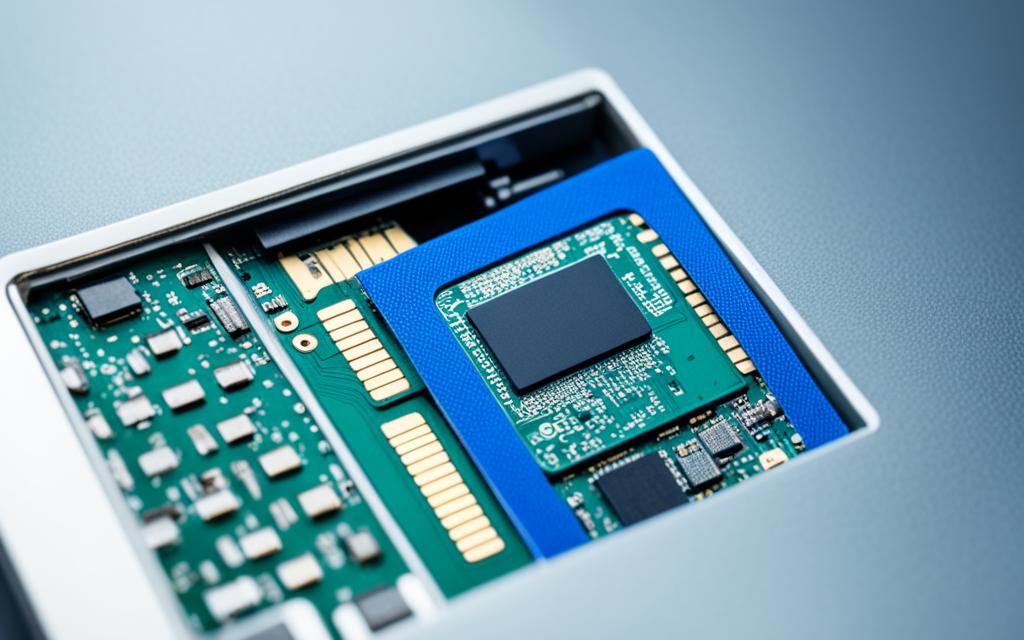Table of Contents
It can be worrying and confusing when your SSD suddenly fills up. You might find that your SSD, which was only about half full, now looks almost completely full. This could mean there are big problems with your SSD’s capacity that need quick fixing.
This article will look into why these surprises in storage happen and how to deal with them. Knowing how your device’s storage works can stop you from losing important data. It also makes your computer run better, making it safer to use. With the right knowledge and tips, you can sort out your storage and use it in the best way.
For guides on the must-have parts for building a computer, visit this page on PC essentials12.
Key Takeaways
- SSD suddenly becoming full can indicate major underlying storage issues.
- Common causes include backups, temporary files, and personal data accumulation.
- Tools like Disk Usage Analyzer can help identify space-hogging files.
- Regularly reviewing installed applications can prevent unnecessary bloat.
- Efficient SSD management is vital for maintaining performance and longevity.
Understanding SSD Storage and Capacity
Solid-State Drives (SSDs) are a big step forward in SSD storage technology. They use flash memory for fast access to data. This gives them an edge over old hard disk drives (HDDs). There are many storage types to choose from. Each has different capacities. You can pick the one that suits your needs best. Initially, SSDs usually started at about 118 GB. It’s important for users to know how this will meet their storage needs today3.
SSDs offer big benefits like speed and durability, which are better than HDDs. However, several things can affect their performance. For example, if an SSD gets too full, it might not work as well. This includes the TRIM feature that keeps the drive working smoothly4. Also, Windows can make big files like hiberfil.sys. These can take up about 50% of the system’s RAM3.
Understanding SSD storage and what affects its capacity is key. Knowing the differences between storage types can help with making decisions on upgrades and taking care of your system.
| Storage Type | Speed | Capacity Range | Typical Use Cases |
|---|---|---|---|
| SSD | Fast | 120GB – 8TB | Gaming, professional video editing |
| HDD | Moderate | 500GB – 16TB | Mass storage, backup solutions |
Knowing how SSD storage works helps users get the most out of it. It also reduces the risks of having a full drive34.
What Happens When Your SSD is Full?
When your SSD gets full, your computer will start to slow down. It struggles because it needs room to work properly. Important processes like Write Amplification and Garbage Collection can’t do their job well. This causes your system to become sluggish. Studies have found that SSDs work best when they have at least 20% free space. This shows how vital free storage is5.
The Impact on System Performance
A full SSD means big problems for how well your computer works. For basic tasks, like installing new programs or updating the system, a lot of space is needed. When a 128GB SSD is almost full, it works 6 to 10 times slower than if it was only half full6. This can be really frustrating. It makes it hard to use important apps or do updates, hurting your work.
Risks to Your Data and SSD Longevity
A full SSD also puts your data at risk. With little space left, the SSD has to work harder. This extra work wears it out faster, shortening its life. Backup programs might add files without you knowing, filling up space quickly. You must keep an eye on your storage. And manage your backups well1. If left unmanaged, this could lead to lost or corrupted files. And you might not be able to get them back.
Common Reasons for SSD Filling Up
Many people find their SSD getting full without warning. This causes annoying slowdowns. By knowing why an SSD can get full, you can find and solve the main problems. This lets you free up more space on your SSD.
Too Many Installed Applications and Games
Having a lot of apps and games takes up a lot of room. This is especially true for programs that need a lot of space. If you keep adding new software without removing the old ones, you might run out of space. The WinSxs folder can also expand, which eats into your SSD’s space7.
Accumulation of Personal Files
Gathering personal files like photos, videos, and documents can cause space issues. These files can pile up without you noticing, using more space than you think. By regularly checking and cleaning up, you can stop your SSD from getting too full. Some hidden files can take up extra space as well, which could be used for other things8.
Failure to Clear Temporary Files and Trash
Temporary files pile up fast, and not clearing them eats into your SSD’s space. Many forget about the importance of deleting browser cache and other temporary stuff. Regular cleaning is vital for the best SSD performance. Using tools like Disk Cleanup helps find and get rid of these unwanted files. This helps avoid your SSD filling up too quickly9.
Why My SSD Suddenly Full?
It can be baffling when your SSD suddenly full happens out of nowhere. Many users face this issue without knowing why. Often, it’s because hidden files build up or automatic backups are made without our knowledge.
For example, there was a case where a 500GB SSD almost reached its limit. This happened after failing to back up to an external drive, which left 130GB of backups on the SSD1kok>. If your SSD is full, you might notice your computer slowing, trouble saving big files, or issues when downloading new software10kok>. These problems can be surprising if you’re not checking your storage regularly.
To fix this, keep an eye on what apps you have installed. Remove any that you don’t need anymore10kok>. Also, make sure to empty your Recycle Bin often and look for large hidden files. This way, you can avoid unexpected storage problems and keep your SSD from filling up.
Taking Control: How to Identify Storage Issues
To keep your system running smoothly, it’s vital to spot SSD problems early. Luckily, Windows offers handy tools for this task. This makes detecting issues much easier.
Using Windows Storage Settings
The Windows Storage Settings help you check how much storage you’re using. By going to Settings > System > Storage, you can see what’s filling up your space. Did you know that around 5% of disk partition space is reserved for the Recycle Bin? This can surprisingly take up a lot of room if not cleared out often11.
For those who like digging deeper, folders like %systemdrive%\Windows\Temp and %userprofile%\AppData\Local\Temp are worth checking. These hold temporary files that can build up11.
Employing Disk Cleanup Tools
The Disk Cleanup tool is great for solving storage issues. It helps get rid of old files, like temporary ones and system restore points11. Using this tool regularly is a smart move for anyone with Windows 10. It keeps your system in top shape.
It’s also smart to manage the WinSxS folder’s size to maintain your system’s health11. And after uninstalling software, consider Stellar File Eraser. It ensures no leftovers remain11.
Solutions for Freeing Up SSD Space
To free up SSD space, start by getting rid of files you don’t need. Look for hidden files that take up a lot of space. By removing these, you can quickly make room on your SSD. This will also make your system run better. Use tools like disk cleanup to find and delete big files that you no longer need106.
Deleting Unnecessary Files and Folders
Deleting unneeded files is a quick way to boost your SSD’s performance. Check for big files you don’t use, like backups or movies. Move them somewhere else to keep enough space for important apps. This will keep your SSD fast and lower the chance of it getting too full.
Uninstalling Unused Programs
Uninstalling programs you don’t use can also help free up space. Sometimes, we keep apps on our devices that we never touch. They use up valuable space and can slow things down10. Take some time to go through your apps and clean out what you don’t need. This will help your SSD work better.
Utilising External Storage Solutions
Think about using external storage, like hard drives or cloud services, for extra data. This way, you can keep your SSD for important stuff and let it run smoothly6. By doing these things, you can take care of your SSD and make sure your computer works well and lasts longer.
FAQ
Why does my SSD suddenly become full even though I haven’t added many files?
Your SSD might seem full due to hidden files or automatic backups during updates. Sometimes, temporary files also pile up. Check your storage regularly to avoid confusion.
What are the key benefits of SSD storage compared to HDD?
A: SSDs access data faster and are more reliable than HDDs. They use less power, which means your laptop’s battery lasts longer. And, they make your device start up faster.
How can a full SSD impact my system’s performance?
A full SSD can slow down your computer. Reading and writing data becomes sluggish. This can cause problems during important tasks and may stop software from updating or installing.
What are common reasons for my SSD filling up unexpectedly?
Installing a lot of apps and games can fill your SSD. So can keeping too many photos and videos. Not clearing out temporary and recycled files regularly also takes up space.
Is there a way to identify potential storage issues on my SSD?
Yes. The Windows Storage Settings can show what’s using your SSD space. The Disk Cleanup tool can also get rid of files you don’t need.
What steps can I take to free up space on my SSD?
You can delete files and folders you don’t need. Uninstall apps that you don’t use anymore. You can also use external drives or cloud storage to hold extra data.
Source Links
- https://forums.linuxmint.com/viewtopic.php?t=328297 – ssd suddenly inexplicably almost full (solved)
- https://forums.linuxmint.com/viewtopic.php?t=340741 – 512GB SSD suddenly full – Linux Mint Forums
- https://www.easeus.com/partition-manager-software/how-to-fix-ssd-full-for-no-reason.html – How to Fix SSD Full for No Reason
- https://www.partitionwizard.com/clone-disk/ssd-is-full.html – What to Do If Your SSD Is Full [7 Solutions] – MiniTool Partition Wizard
- https://www.kingston.com/en/blog/pc-performance/full-ssd-solutions – What to Do if Your SSD Is Full
- https://www.diskpart.com/windows-10/ssd-full-for-no-reason-0001.html – Effectively Solved: SSD Full for No Reason in Windows
- https://www.makeuseof.com/windows-c-drive-fills-unexpectedly/ – 6 Fixes if the C: Drive Keeps Filling Up for No Reason on Windows
- https://www.diskpart.com/articles/my-c-drive-is-full-without-reason-4348.html – Solved: My C Drive Is Full Without Reason in Windows 11, 10, 8, 7
- https://www.partitionwizard.com/partitionmagic/c-drive-keeps-filling-up.html – Fixed: C Drive Keeps Filling up for No Reason (Works 100%) – MiniTool Partition Wizard
- https://recoverit.wondershare.com/partition-tips/fix-ssd-full-for-no-reason.html – How to Fix SSD Full for No Reason[2024]
- https://www.stellarinfo.com/blog/my-c-drive-is-full-without-reason/ – Fix Issue: My C Drive is full without reason








